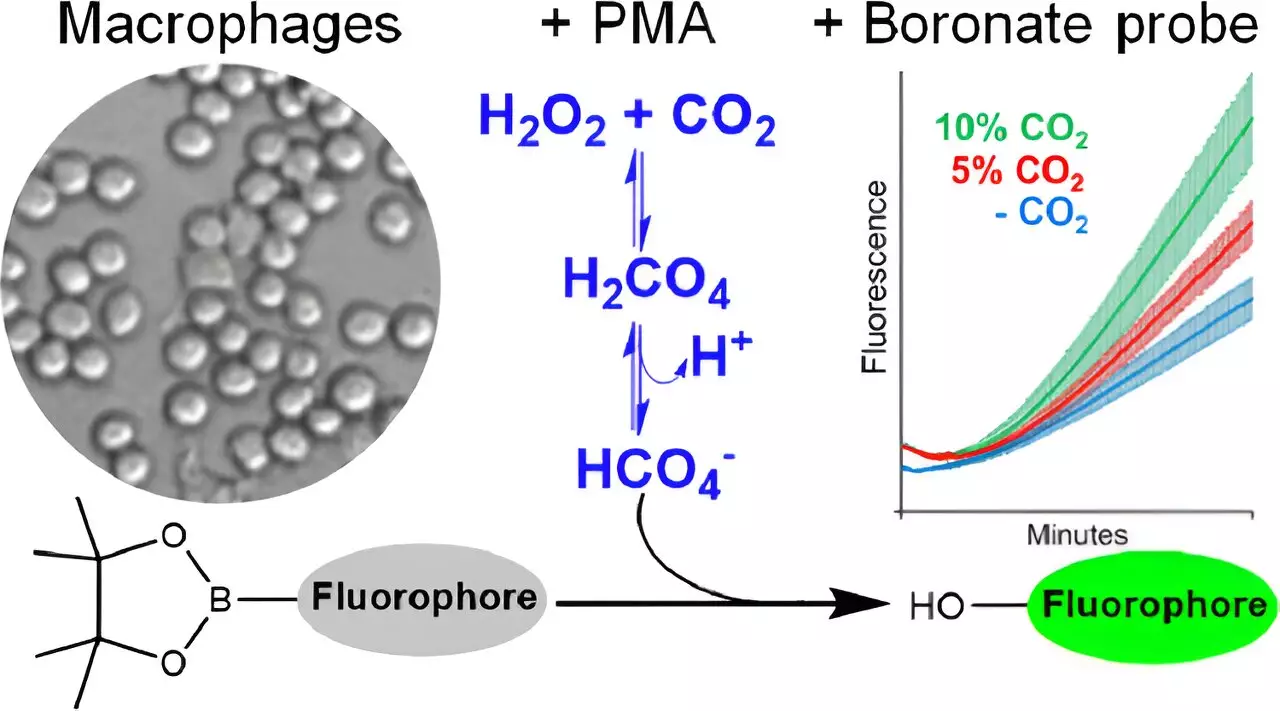Understanding the multifaceted role of carbon dioxide (CO2) in our environment has become increasingly crucial as more evidence highlights its influence beyond climate change. At the forefront of emerging research is the transformative interaction between CO2 and specific biochemical agents within human cells. This article seeks to examine the intricate relationship between CO2 levels, the oxidizing agent hydrogen peroxide (H2O2), and the formation of peroxymonocarbonate, a compound gaining traction for its significant roles in cellular responses and dysfunction.
Recent research led by Ohara Augusto at the University of São Paulo sheds light on peroxymonocarbonate, a powerful oxidant that forms in the presence of CO2 and H2O2. With rising levels of atmospheric CO2 threatening both environmental and human health, the investigation into how these gases interact has taken on added importance. Peroxymonocarbonate was long overlooked as a critical factor in cellular biochemistry due to its low formation propensity and the challenges associated with its detection in biological systems.
Using innovative fluorescence techniques, Augusto’s team has pioneered a novel methodology to identify peroxymonocarbonate in living cells, marking a significant breakthrough in redox biology. By employing specialized boronate probes that react with different oxidants to produce measurable fluorescence, researchers can now ascertain the presence of peroxymonocarbonate under physiological conditions.
CO2, often vilified as a greenhouse gas, also plays a significant role as a precursor in the formation of peroxymonocarbonate. Every day, human metabolism produces about 1.0 kg of CO2, which enters a complex interaction within the body, affecting the reactivity of other metabolites such as hydrogen peroxide. As cells experience oxidative stress, the interplay between CO2 and H2O2 becomes increasingly relevant. Elevated CO2 levels not only alter oxidative pathways but also influence gene expression related to inflammation and overall cellular signaling.
Importantly, the mechanism of oxidative damage instigated by CO2 remains partially illuminated. Various studies suggest that the production of peroxymonocarbonate may underpin some toxicological consequences linked to increased CO2 levels. Continuous exposure affects how cells adapt, signaling pathways, and the potential to generate oxidative stress responses.
The emergence of peroxymonocarbonate in biological systems introduces a new variable in understanding cellular function and dysfunction. Augusto emphasizes that while cells can adapt to mild stress through redox signaling, significant oxidative overload can lead to irreversible cellular damage. Research indicates that the oxidizing nature of peroxymonocarbonate might facilitate protein modifications, pushing cellular responses into maladaptive territories when CO2 levels become overwhelming.
Macrophages, which play a pivotal role in immune responses, have been central in studies assessing the generation of peroxymonocarbonate. Findings showing that macrophages can synthesize this compound upon activation, particularly in the presence of CO2, provide insights into how immune responses may be affected in an increasingly CO2-rich environment.
Future Directions in Research
As scientists endeavour to fully explore the redox dynamics at play, it is clear that peroxymonocarbonate needs to be scrutinized more comprehensively. The relatively simple detection methodology introduced by Augusto’s research enables ongoing inquiries into the potential pathological roles of peroxymonocarbonate as a biological oxidant. Further investigations could reveal its implications for various health conditions linked to oxidative stress and inflammation, particularly in urban settings where CO2 levels may spike.
While the narrative surrounding carbon dioxide often emphasizes its environmental ramifications, the biochemical implications of increased CO2 levels are equally compelling. The interaction with hydrogen peroxide to form peroxymonocarbonate opens up new avenues for understanding cellular health and disease. The journey to unravel the biochemical complexities associated with CO2, peroxymonocarbonate, and cellular responses is just beginning, necessitating a paradigm shift in how we view the effects of this ubiquitous molecule in both our environment and our bodies.
Much remains to be uncovered about the harmful and beneficial roles of peroxymonocarbonate in biological systems, and future research could usher in a fundamental re-evaluation of how we approach carbon dioxide, not only as a climate issue but also as a critical element in human health and disease.

